by Christopher Hector
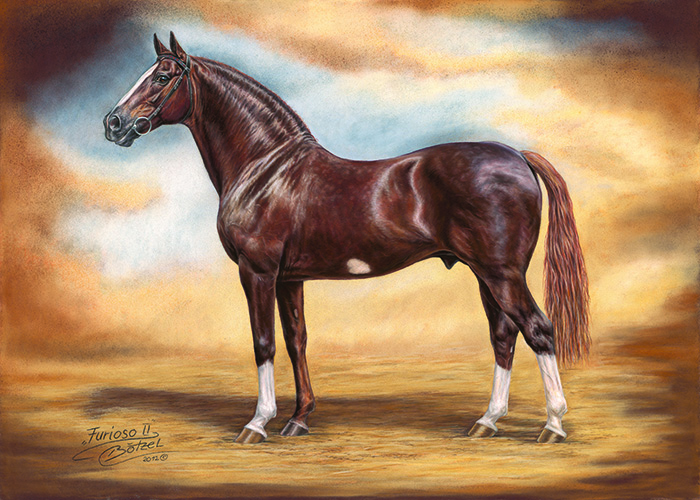
The first thing to be said about this year’s Hanoverian dressage stallions’ rankings, is that once again, the dominant influence on the modern dressage horse is a stallion from France, you know the place where they can’t breed dressage horses, Furioso II. Furioso II is by the Thoroughbred (Thoroughbred, you know those horses that can’t do dressage) stallion, Furioso out of the Selle Français (yes, the ones with no mouth) mare, Dame de Ranville. Although there is no doubt that master breeder, Georg Vorwerk imported Furioso II in 1968 with jumping in mind, and Furioso II has been an extraordinarily influential stallion in the world of showjumping, his blood dominates dressage, even today, 53 years after the death of the stallion.
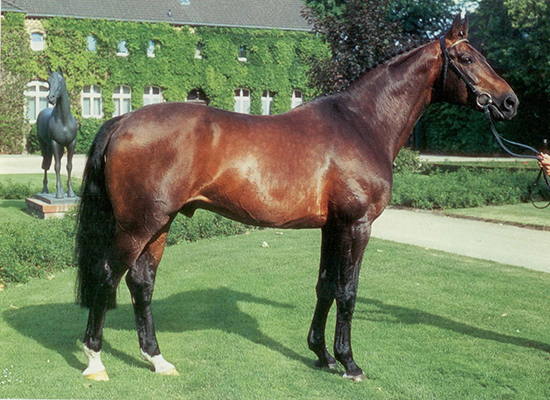
Florestan
Of the twenty top dressage sires in this year’s Hanoverian Stallion book, seven descend from Furioso II, all of them via his grandson, Florestan (Fidelio / Rheingold), with two more sitting in 21st and 22nd – Fürstbischof (Fürst Romancier / Plaisir d’Amour) and Fidertanz (Fidermark / Frühlingstraum II).
It is also noteworthy how consolidated the other lines are on the pedigrees of these stallions. Over and over again, we see the same names, it is a bit like the consolidated bloodlines we have become used to on jumping pedigrees. Gone gone gone are the days when the dressage horse was a fluke, the one that was no good over a fence.
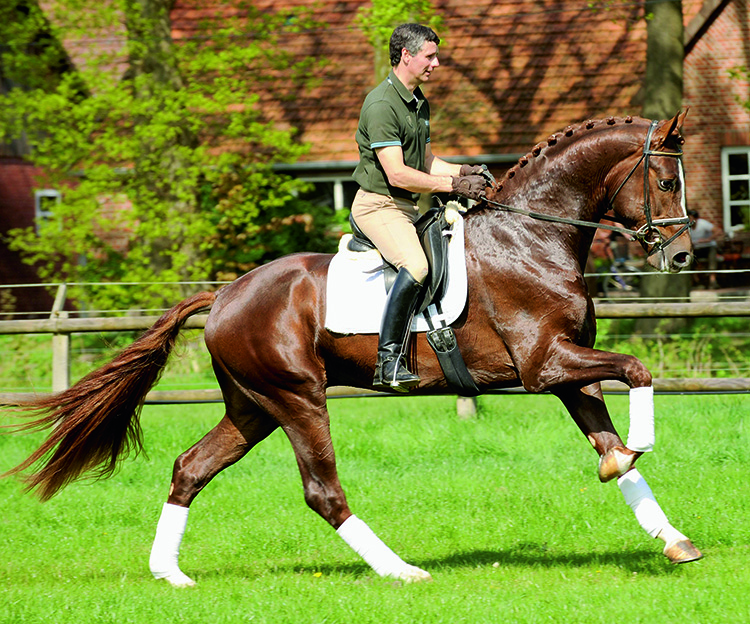
Floriscount
The highest ranked F stallion, Floriscount in 3rd, is a perfect example of this. Floriscount’s sire, the Florestan son, Florencio (himself a world champion young dressage horse two years running) is out of a Weltmeyer mare. Floriscount’s dam, Arkon is by Donnerhall, but the final mare line is enriched by two of the Thoroughbred stallions that played such a key rôle in transforming the Oldenberger from coach horse to equestrian athlete, Tin Rod and Vollkorn.
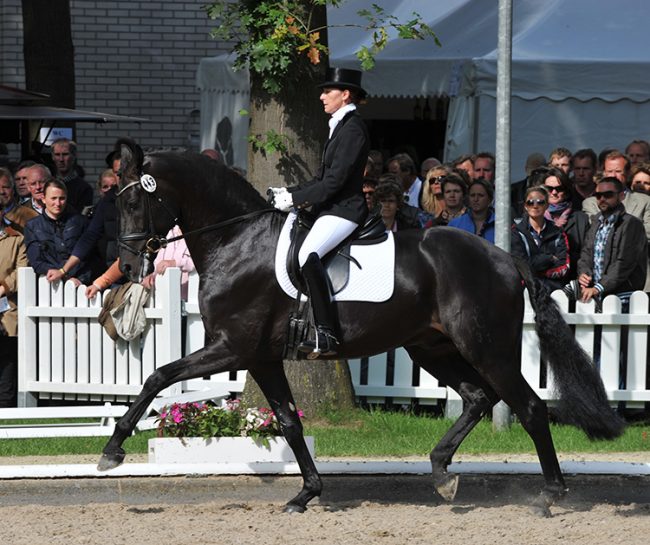
Fürstenball
Fourth ranked Fürstenball is by Fürst Heinrich, a son of Florestan out of a Donnerhall mare. Fürstenball was bred by one of the last of the old time Oldenberg breeders, Georg Sieverding, who died in 2018. I was lucky enough to visit the Sieverding farm and interview Georg in 2012, and to keep the theme running, his mentor was Georg Vorwerk: “Georg Vorwerk was my friend, we travelled a lot together. I spoke with many breeders, but Georg Vorwerk was my main advisor. What was important for him was to see a foal at the age of three days, three weeks, three months. For Georg Vorwerk the correctness of the gaits and the bones was very important. You must have a sound horse with a very good temperament and character. The hind leg was always very important, the engine has to be correct.”
Fürst Heinrich was the world young dressage horse champion in 2003 and tragically died two years later, but not before siring some exceptional foals including Fürstenball, and the eighth ranked, Fürst Romancier (out of a mare by the Rosenkavalier son, Romancier).
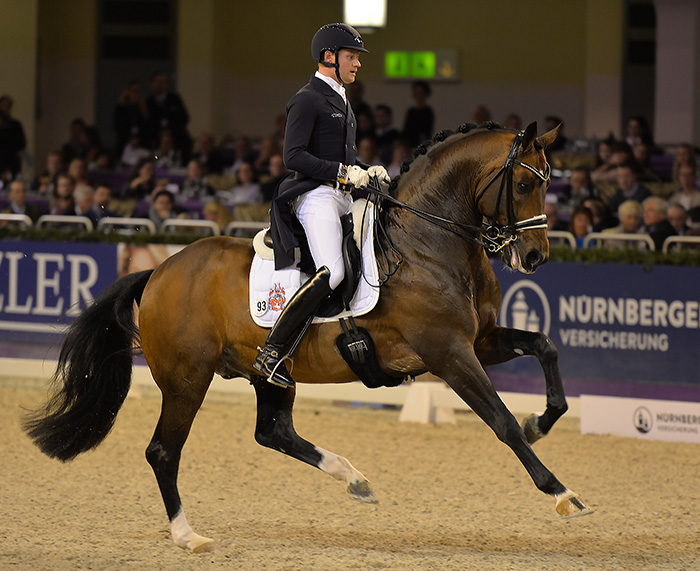
Foundation
Ranked ninth is one of the up-and-coming stars of German dressage, in the breeding barn AND the competition arena, Foundation (by the Fidermark son, Fidertanz out of a mare by the De Niro son, De Vito). The powerful bay stallion is showing great promise at Grand Prix level with Matthais Alexander Rath, and is one of the most popular stallions in Germany.
In eleventh we find Fürsten-Look, by Fürstenball out of a Londonderry / Weltmeyer mare. In fourteenth, For Complement (by Fidermark out of a mare by the Calypso II son Complement). Seventeenth, For Romance (Fürst Romancier / Sir Donnerhall).
That’s it, seven out of twenty!
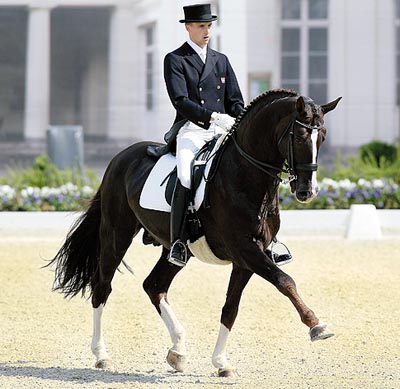
Don Schufro
But the ‘D’ line that has dominated for so long has not disappeared. This year’s highest ranking of 144 is shared by Don Schufro and Dimaggio. Don Schufro (Donnerhall / Pik Bube I) died in 2020 at the age of 27, after a competition career that culminated in a team bronze and individual 10th in the Freestyle at the Beijing Games, and a breeding career that saw him at the top of the WBFSH rankings year after year. He sired a number of good GP horses and two superstars, the mare Weihegold (Sandro Hit) and the stallion, Diamond Hit (Ramino). Lucky then that it was not revealed that he was a WFFS carrier until 2019 after he had retired from stud…
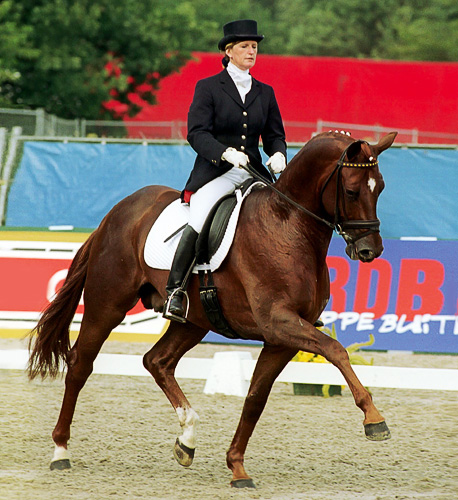
Dimaggio
Dimaggio is out of a mare by World Cup I, and was trained initially by Hans Heinrich Meyer zu Strohen before his owner, Suzanne Davies took over the ride, and won a World Young Horse Championship in 2000. The stallion was popular in the UK, but his opportunities increased when he spent the last years of his life at first Gestüt Vorwerk, and later, Stallion Station Böckmann. He died in 2015.
De Niro flew the flag for the D line for many years and right now the search is on for the new D line star and perhaps we have found one in Dimaggio Black who recently topped the Münster Stallion Sport Test with a 9.45 – 9.5 for walk, 9 for trot, 9.5 canter, 9.5 for training and 9.5 for perspective.
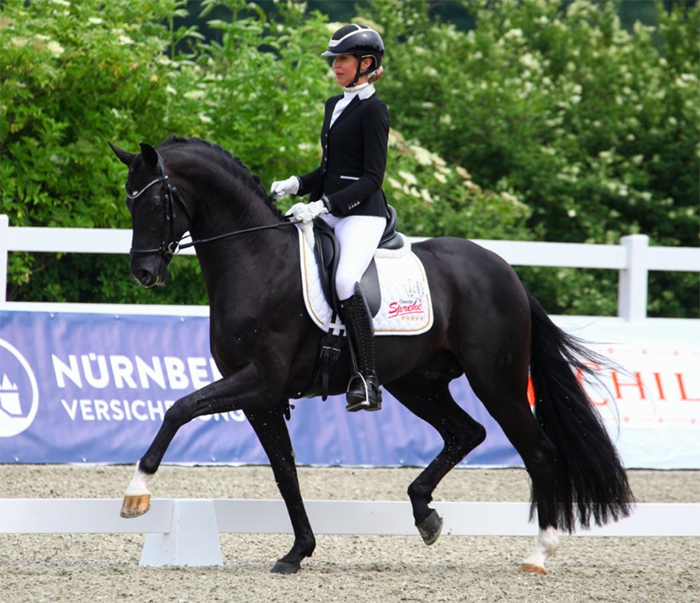
Dimaggio Black
The young stallion was bred at Sprehe Stud farm, out of Feela, a mare by Fürst Heinrich, but then the blood travels to Holstein in the form of Varida, a mare by a half blood stallion, Famos, out of Nerina who is 75% Thoroughbred.
Dimaggio Black also comes from a proven family. Let his rider, the incredibly talented Simone Pearce, explain. “We also have Diamond First who is by Diamond Hit and out of Feela. He is six years old and won his international debut last year and qualified for the World Young Horse Championships. We also have a ten year old out of her by Christ, who is now ready for Grand Prix, so I know the family.”
“Dimaggio Black has an amazing character, we always say it seems like he has been here before because he takes everything in his stride and learns so so quickly. I have been riding him since he was first broken in, I think I started riding him after he had had about twenty rides. I loved him from the first time I saw him and I’m very happy and proud of how he has developed over the past two years. He has become very popular as a breeding stallion – his first foal was born a couple of days ago, but he remains very focused and fantastic to train and develop in his sports career.”
Story continues below the advertisement
Other representatives of the D line in the top twenty are the 5th ranked Don Frederic by Don Frederico (another victim of the WFFS hysteria) out of a mare by Wolkentanz – who has competed with very modest success at Small Tour level with the Brazilian, Rudolpho Riskalla. Diamond Hit himself ranks 15th, while the promising younger stallion, Danone I (De Niro / Weltmeyer) ranks 20th.
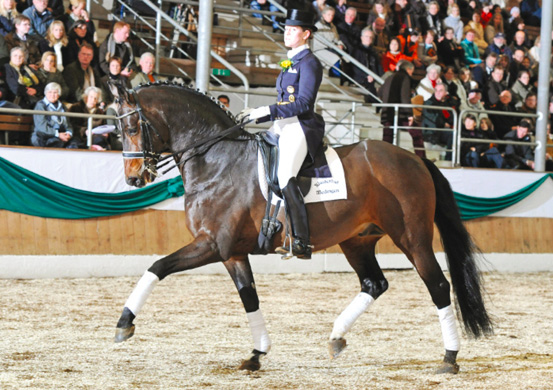
Danone
Although Danone was bred by Dr Bianca Helmicke, he is very much a product of Burchard Wahler’s Klosterhof Medingen, the home for so many years of his sire, De Niro, and his rider at national Grand Prix level is Burchard’s daughter, Therese. He has a full-brother, Der Designer competing with moderate success in the small tour with the British rider, Michael Eilberg.
Not only do I look forward every year to the arrival of the Hanoverian Stallion book, but I also look forward to the commentary from my friend, Dr Ludwig Christmann, who also edits the book. He looks at both the Hanoverian rankings and the FN values and, quite rightly, draws attention to the rôle of the B and S lines. Here is his article in full, and my thanks to the Hannoveraner Verband for the translation:
FOR THE BIG SPORT
The new breed values are available. Which younger stallions are pushing ahead? Which producers with Grand Prix qualities are available to breeders of Hanoverian and Rhineland horses? This first part is all about the discipline of dressage.
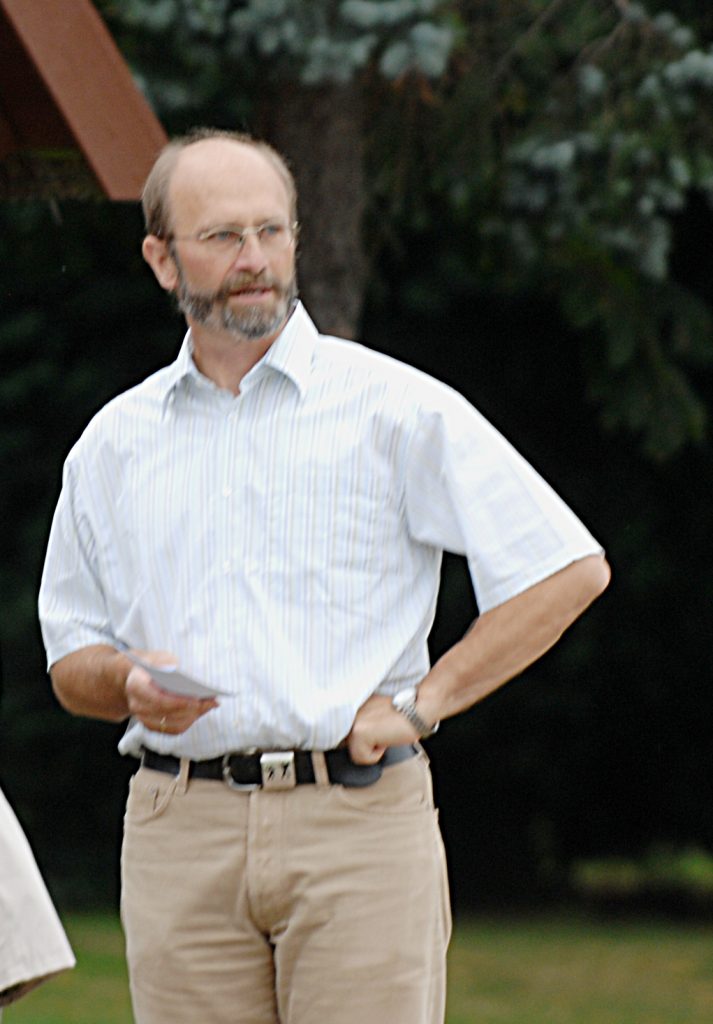
By Dr Ludwig Christmann
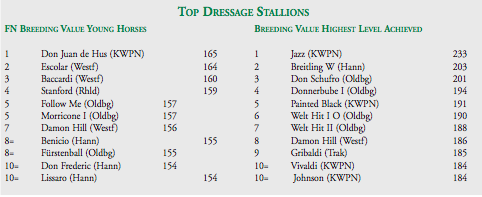
At the end of every year, the results of the breed value estimations become available. The FN-breed values cover the breed developments in the disciplines of dressage and jumping. The two breed values “highest reached level” and “young horse classes” are taken into account in the following charts. The breed value called “young horse classes” includes the results of mare tests, the various types of stallion performance tests and tests at the base level, in other words dressage and jumping horse classes. The breed value called “highest reached level” (HEK) includes the level of difficulty at which a horse competes. A bonus is given for a victory or a placing. The more descendants of a stallion successfully compete at the higher levels, the higher the breed value. This explanation is a bit simplified, since the breed value estimation also takes into consideration information about other descendants, and – if possible – also about the conditions.
In dressage, the ultimate breeding goal is producing a Grand Prix horse, in jumping, the highest level has been reached, when the jumps measure 1.60 metres. However: Competitions are not a performance test in the classical sense, in which animals are compared to each other under standardized conditions. Rather, strong environmental influences like training, riders and so forth have a significant impact. Especially at the highest international levels, the limiting factor might not be the horse’s talent, but the number of riders, who are competitive at these levels. In spite of this limitation, the new HEK-breed value produces valuable information about the heredity of stallions. Regarding analyzing the breed values, we are especially looking at the younger generation of stallions, and at those stallions, which stood out because they have been producing Grand Prix horses.
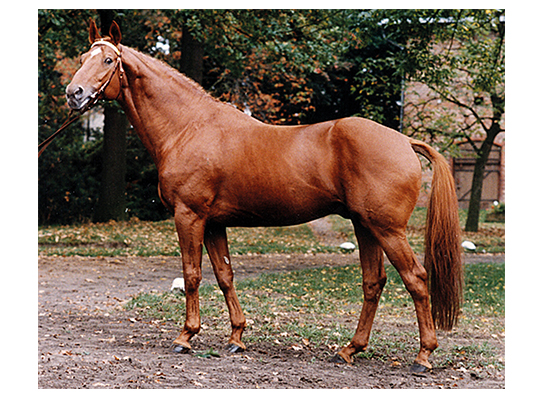
Bolero’s descendants
The Dutch producer legend Jazz (breed value BV 233) heads on the list of the top-ten stallions in the HEK-breed value estimation. The proven Grand Prix sire Breitling W (breeder: Hermann Niehus, Rahden) follows closely with the very good breed value of 203. He represents the highly successful dressage line of Bolero. Here the stallions Benetton Dream and Belissimo M and their sons currently take centre stage.
Benetton Dream competing at the Bundeschampionat with Holga Finken
Benetton Dream by Brentano II/Rotspon (breeder: Axel Windeler, Verden-Walle), the national champion of riding horses in 2007 with rider Anna Fiebelkorn, was also victorious at the Grand Prix with Tinne Vilhelmson-Silfven and stands at stud on the Swedish breeding farm called Loevsta. His high HEK-breed value of 156 proves that he passes his talent on to his offspring. His oldest descendants currently are only 11 years of age, yet nine of them are already successful at the Grand Prix-level.
Belfast is one of them. Peter Hermann Rabeler from Winsen bred him out of a dam by Florestan. He found a new owner at Verden’s winter auction in 2014. As a nine-year-old, he already had numerous Grand Prix placings up to the S4*-level.
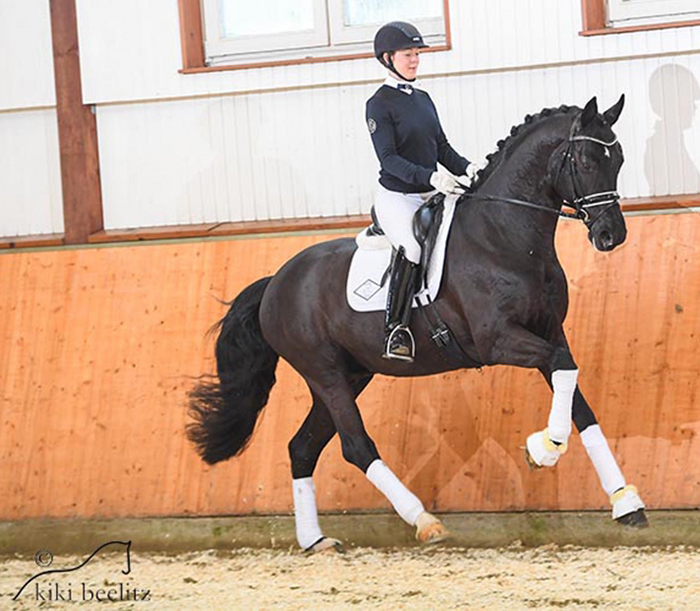
Bon Coeur
Bon Coeur out of a dam by Sandro Hit (breeder: Birgit Tietjen, Taaken) is one of Benetton Dream’s currently registered, hopeful sons. His breed value “young horse classes” is 153. This black stallion was the vice national champion in 2015 and 2016 with Lena Berwe and Christin Schuette. Last winter, he won his first Prix St Georges in Florida with rider Caroline Darcourt. As a producer, he currently is one of the most important young Hanoverian dressage stallions.
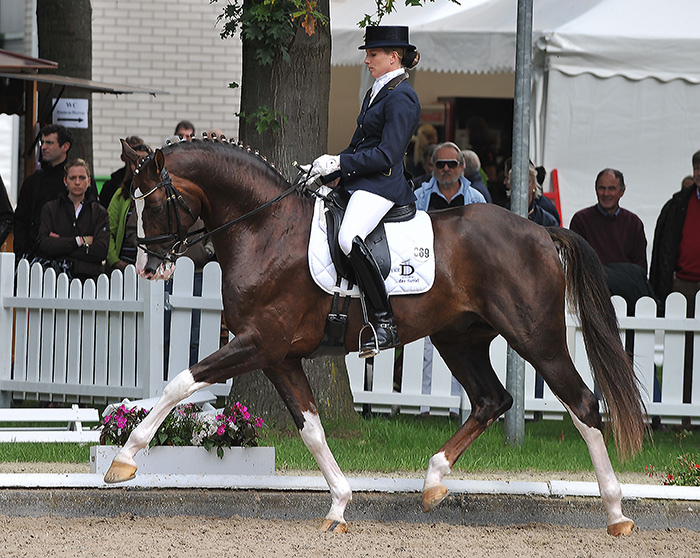
Benicio
The second, current top producer out of the Bolero-line is Belissimo M (Rhineland) by Beltain/ Romadour II (breeder: Dieter Niesar, Kranenburg). The most important son of this Hanoverian Stallion Of The Year 2019 is Benicio, born 2005 (breeder: Wilhelm Stadtlander, Lilienthal). He was the national champion in dressage in 2011 with rider Anna Fiebelkorn and is victorious at the Grand Prix with Jessica Lynn Thomas. With a young horse breed value of 155, he is one of the top ten highest-valued young producers and has very promising sons like Baron and Bonds.
Don Schufro (BV 201), Donnerbube (BV 194) and Damon Hill (BV 186) are three sons of Donnerhall, which are in the top ten of the HEK-breed value estimation. This confirms the continued leading position of this line at the Grand Prix-level. Without a doubt, De Niro (HEK-breed value 162; breeder: Brigitte Pahl, Fockbek) is the most important son of Donnerhall. For several years, he led the WBFSH-world rankings for dressage horse-producers. Which stallion will step into his footprints?
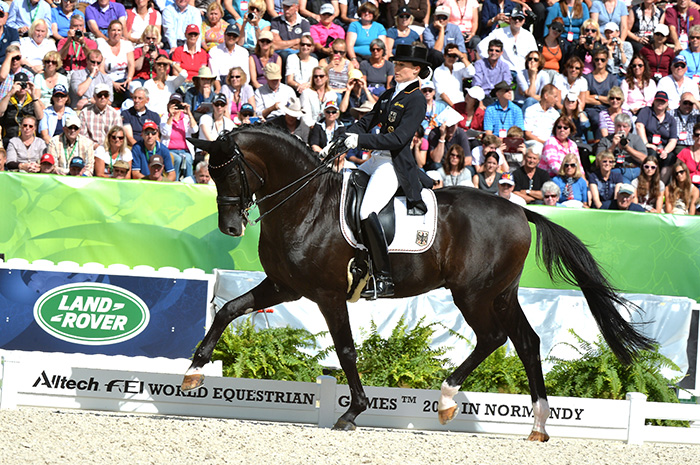
Desperados
His already deceased son Desperados FRH (breeder: Herbert Schuett, Hemmoor) comes to mind. He is his most successful descendant in competition. With Kristina Broering-Sprehe, he was a member of the German team winning gold at European Championships, at World Championships and at the Olympic Games. His HEK-breed value of 156 signals that he passes his talent on to his offspring. The statistics reveal that twelve descendants successfully compete at the Grand Prix-level, four of them at the S****-level.
Destano is one of his approved sons who also has Grand Prix victories with Simone Pearce, and he has been heavily used for breeding.
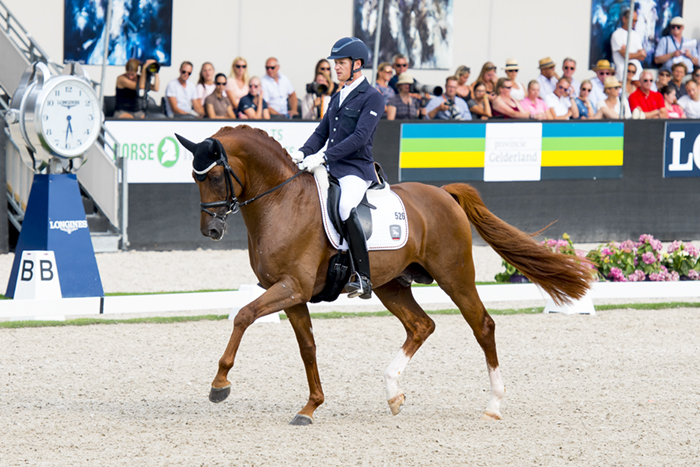
Destacado
And then there is Destacado, which became the vice world champion of young dressage horses in 2018 with rider Matthias Alexander Rath. As a just seven-year-old, he has multiple victories at the Prix St Georges-level. Heinrich Giesselmann from Barver bred both stallions. Both found good homes at Stud Sprehe and at the Schafhof. Both places will make sure that the stallions will be trained to the highest level.
The breed value for young horse-classes of 154 of the stallion Don Frederic by Don Frederico/Wolkentanz (breeder: Beate Wedermann, Wangerland) certifies his sons and daughters a great talent for dressage. With this breed value, Don Frederic is also in the top ten in Germany. The eleven-year-old, powerfully moving stallion of the Schafhof is also actively competing. In 2020, Rodolpho Riskalla rode him successfully up to Inter I.
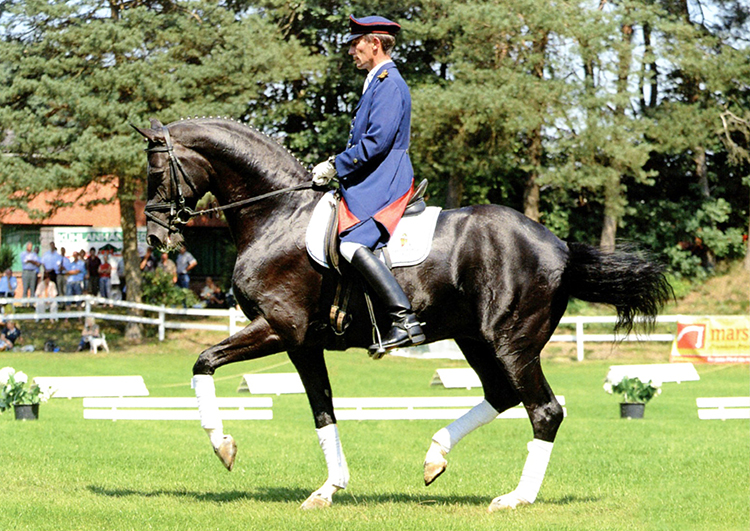
Dancier
The descendants of the retired approval champion and state stud sire Dancier by De Niro/ Lancier (breeder: Ekke Thaden, Butjadingen) are also on the right track. A HEK-breed value of 147 confirms a positive heredity with respect to a predisposition for upper levels. Fifteen of his descendants have reached Grand Prix-level; three of them compete at the S4*-level. Dark Dancer (breeder: ZG Bialek and Wolf, Osterode) is one of them. With rider Elisa Prigge, he is highly successful in Lower Saxony. Fortunately there are numerous descendants of Dancier, which pass on his valuable genetics. Don Nobless (breeder: ZG Hey, Geestland) from the Station Pape is another one. He won Grand Prix classes with Susan Pape and has been the most profitable descendent of Dancier.
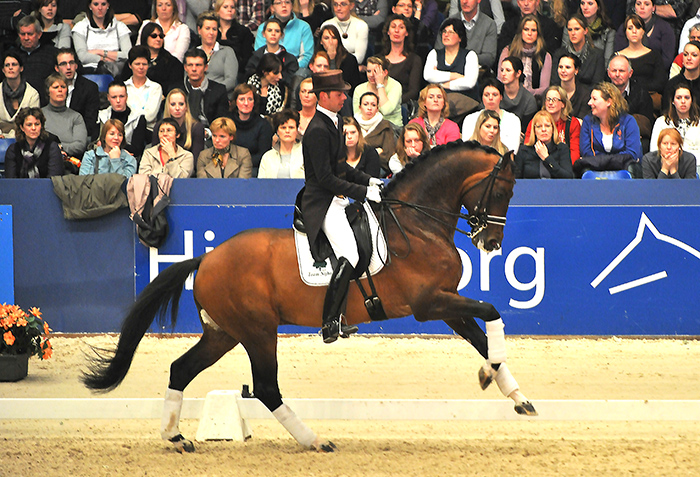
Florencio
One of the most popular stallion lines is the line of the Rhineland stallion Florestan, which goes back to Furioso xx. Florencio, a son of Florestan, is the stallion from this line with the highest HEK-breed value of 164. Florencio is a Westphalian stallion out of the Hanoverian dam line of Spechtlied. He was the world champion of young dressage horses in 2004 and 2005 with rider Hans Peter Minderhoud. While standing at stud in the Netherlands at the farm of Henk Nijhof, breeders from Germany also used him a lot. Ninety four of his descendants successfully competed in dressage at the S-level, 19 of them made it to the Grand Prix-level, and five competed at the S****-level. The 2009-born Ferdinand BB (breeder: Bernhard Sieverding, Twistringen) is one of his greatest Hanoverian hopefuls. With rider Jessica von Bredow-Werndl, he has already won numerous Grand Prix-classes. Several sons continue passing on Florencio’s genetics. Floriscount, a Grand Prix competitor himself, probably is the most influential.
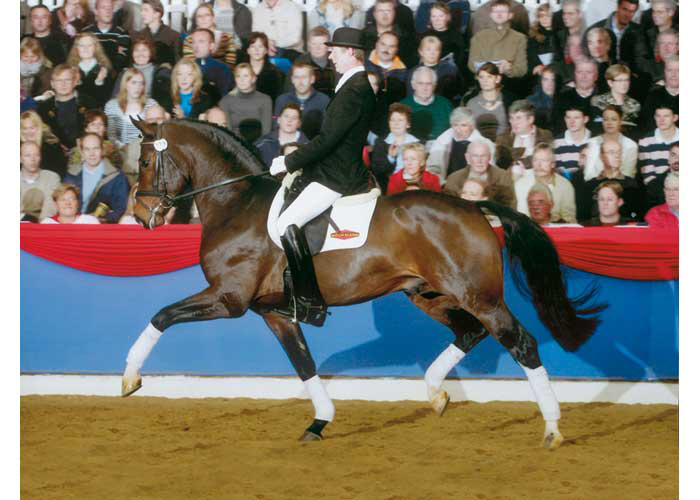
Fidertanz
The Rhineland stallion Fidertanz by Fidermark (breeder: Hermann Schult, Huenxe) greatly influences the Hanoverian breed. Fidertanz stands at stud on Klosterhof Medingen and on the breeding station Böckmann. The vice national champion from 2005 was successful up to the highest level in dressage with rider Antonio Teixeira do Vale. The following are important sons of Fidertanz, which also successfully compete up to Grand Prix: Fahrenheit (BV young horses 139; breeder: Andrea Heitmann, Dinklage), Foundation (BV young horses 151; breeder: Gerd Pigge, Lastrup) and Franziskus (BV young horses 126; breeder: Elisabeth Albers, Loeningen). Fidertanz has already produced 26 successful Grand Prix-competitors including seven, which compete up to the S****- level. The WBFSH-world rankings of dressage producers confirm his importance. He ranks in seventh position and has been in the top ten for two consecutive years. The above-mentioned Franziskus is his highest ranked competitive descendant placing 38thin the world rankings with rider Ingrid Klimke.
Fürstenball by Fürst Heinrich/Donnerhall from the station Schockemöhle is one of the most popular German dressage sires. He had been the national champion of dressage horses in 2011. Just like his sons Follow Me (BV 157) and Fuersten-Look (BV 153), he is one of the highest valued stallions in the BV young horse-classes with 154 points. Even though he holds the highest breed value for type (163) of all current producers, as the Hanoverian breed value-estimation shows, his offspring sometimes lack the stability of conformation. The oldest descendants of this sire are now 10 years of age. 49 of them already compete successfully at the S-level, including five at Grand Prix. It will be interesting to see how his descendants will establish themselves in dressage at the most difficult level in the years to come.
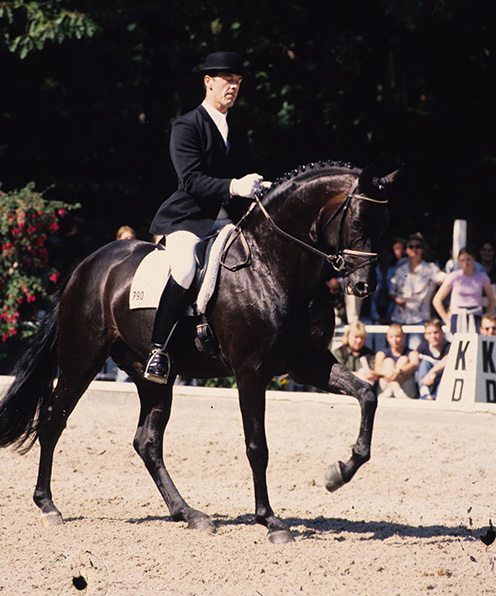
Grand Prix horses by Sandro Hit
Against initial scepticism, another famous stallion from the Schockemöhle station reached the status of being a producer of Grand Prix dressage horses. We are talking about Sandro Hit, the dressage horse national champion and world champion of young dressage horses in 1999. With a HEK-breed value of 155, Sandro Hit is clearly rated positively. The numbers, which form the basis of this breed value, are pretty impressive. 1,061 descendants obtained placements in dressage – 204 of them in classes at the S-level. 59 have successes in S***-classes, 22 in S****-classes and two in S*****-classes. In his successful, rising dressage-stars, we often find Donnerhall’s genetics on the dam side of the pedigree. This is the case with his most successful descendant, which carries the Hanoverian brand. It is Dorothee Schneider’s Showtime FRH (life earnings: 230,697 Euros), a team Olympic champion in Rio de Janeiro in 2016. Heinrich Wecke from Stadthagen bred him out of a dam by Rotspon/Donnerhall, which stands for very rideable blood. Since several years, Sandro Hit is one of the top three dressage horse producers in the WBFSH world rankings, which also underlines his value as a dressage horse producer.
Sir Donnerhall
Several sons of Sandro Hit now have higher HEK-breed values than he does. Sir Donnerhall (dam by Donnerhall), the national dressage champion and vice world champion of 2006, was rated highest with a value of 172. He too has successful descendants, a total of 1,067 dressage stars, including 210 with victories and placements at the S-level. Fifty five reached the Grand Prix level, eleven are successful at the demanding S****-level, and one successfully competes at the top international S*****-level.
Stanford and Dorothee Schneider and the young horse championships in Verden
Stanford is an interesting son of Sir Donnerhall from the Rhineland and out of a dam by Sandro Hit. His breed value young horse-classes of 159 is one of the highest rated for a German rising sire. Yet the 2009-born stallion, which was born on the farm of Anton and Uwe Mengelaers in Geilenkirchen, was not used much at all as a breeding stallion. In 2014 and 2015, he placed in the finals at the World Championships for young dressage horses in Verden with Dorothee Schneider. As an eight-year-old, he won dressage classes at the S-level with rider Matthias Bouten. His son Sole Mio (breeder: ZG Wencek, Sonsbeck) was discovered on Verden’s stallion market in 2016, and has since become one of the most successful rising dressage horses in the USA. Sir Donnerhall is listed in 14th place in the WFBSH-stallion ranking.
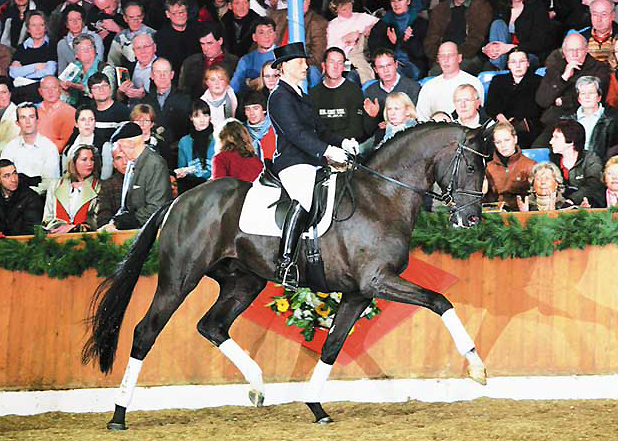
San Amour
Another son of Sir Donnerhall is listed higher, in ninth position. His name is San Amour. In the HEK-breed value estimation, he obtained very good breed value of 158. Out of 70 descendants with successes at the S-level, 28, which equal 40%, have reached the Grand Prix-level. That is a fantastic result.
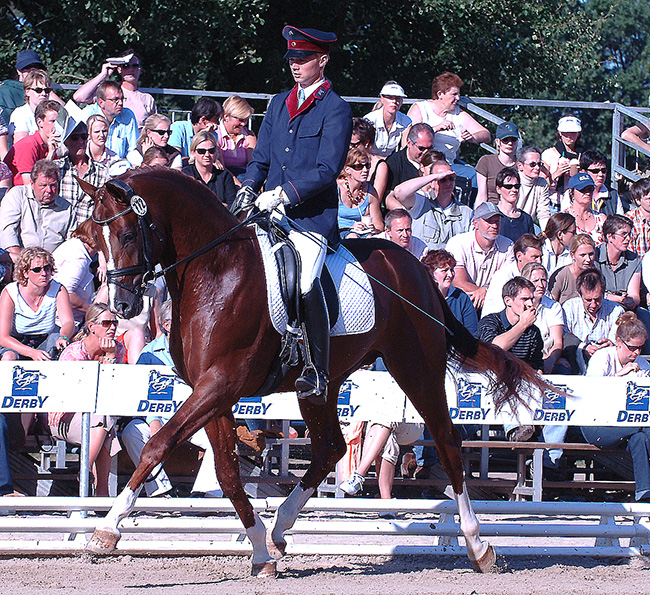
Quaterback prevails
There are a few parallels between Sandro Hit and Quaterback. Both were national champions (Quaterback in 2006 as a three-year-old stallion), both belonged to those dressage horse producers, which were highest in demand in Germany, but both also divided breeders into either great fans or firm rejecters. Just like Sandro Hit, Quaterback in the end prevailed as a performance producer, which his HEK-breed value of 155 and a fourth place in the WBFSH-ranking for dressage horse-producers reflect. Out of 87 descendants with successes at the S-level, 19 already reached the Grand Prix-level. His oldest descendants are only 13 years of age, in other words, many are not yet mature enough for Grand Prix-classes. Ten-year-old Quantaz out of a dam by Hohenstein, is most successful. Quantaz had the good fortune – but also the talent – to get to Isabell Werth. In 2020, the pair participated in six Grand Prix-classes, and won them all.
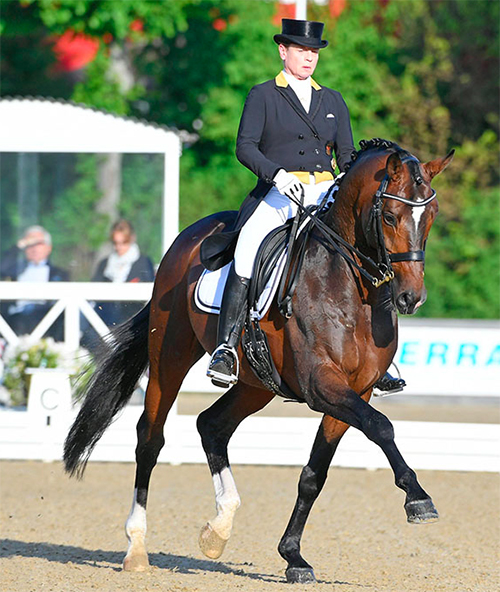
Quantaz (photo credit – KH Frieler)
Quaterback Junior FRH (breeder: Gerd Janssen, Neuschoo) is listed in 32nd place in the world ranking for dressage horses. Nicolas Wagner from Luxembourg very successfully competes this former auction foal from Verden.
Celle’s, twelve-year-old state stud sire Quaterhall, a son of Quaterback (breeder: Ulrich Kriebel, Bienenbuettel) has placings at the S***-level with rider Wolfhard Witte. His breed values (HEK:137; young horses:129) are very promising.
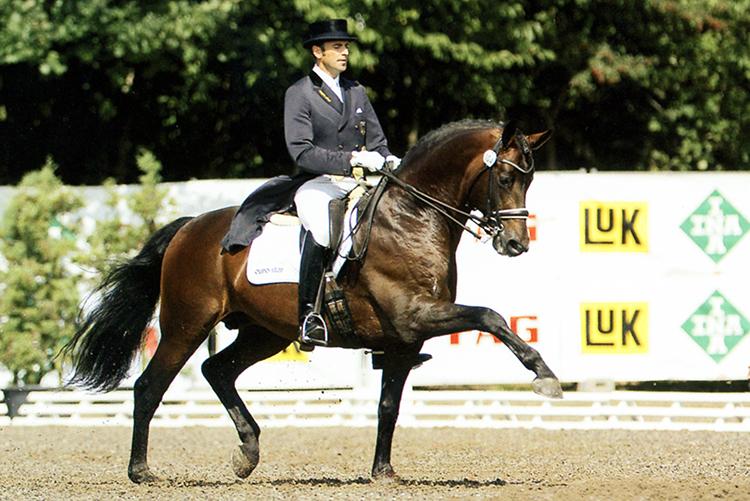
Lord Loxley, the dressage star from the Rhineland
Lord Loxley by Lord Sinclair/Weltmeyer (breeder: Breeding Farm Sonnenhof, St Vith/BEL) is one of the very sought-after and successful dressage producers from the Rhineland. The national dressage champion and vice world championship from 2004 was victorious up to Inter I with rider Jana Freund. Ninety of his 388 descendants with dressage successes – almost one-fourth – have successes up to the S-level, 16 up to Grand Prix, which granted him a high HEK-breed value of 168. With a young horse-breed value of 148, his son Lord Carnaby (breeder: Peter Schweimanns, Nettetal), the national champion from 2013, is also highly valued. Lord Leatherdale by Lord Loxley (breeder: ZG Pleines, Uedem) has established himself as a top producer in the Netherlands.
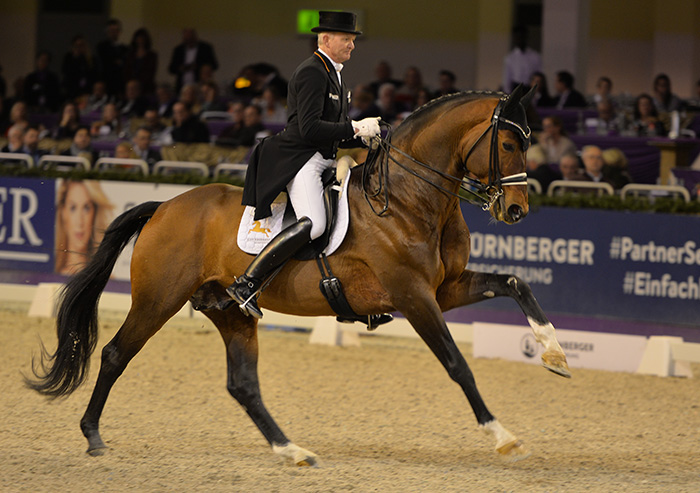
Escolar
Two additional names appear in the top ten of the breed value-estimation. Their lines will most probably gain in importance in the coming years: Escolar by Estobar NRW (Hanoverian stallion line of Adeptus xx) with the second-highest breed value of 164 and Morricone with the breed value of 157. Escolar was the national champion in 2012 and in 2013 with Hermann Burger; with Hubertus Schmidt, he has won numerous Grand Prix classes. He passes on to his offspring his powerful moving dynamics, which are very sought after. His sire Estobar NRW also placed at the Grand Prix-level. With a HEK-breed value of 153, he also is highly rated.
![]()
Morricone
Morricone represents the line of the Trakehner top producer Millennium, whose importance has drastically increased over the last years. The trademarks of this line are powerfully moving horses with large bodylines often with dark coats. Here too it is to be expected that numerous representatives of this line will mature fulfilling the demands of the higher levels of the sport of dressage.
Two lines are still missing in this analysis: They start with the letters R and W. There are highly assessed representatives of both lines in the breed value estimation HEK. The full-brothers Welt Hit I and Welt Hit II by Weltmeyer represent the W-line. With breed values of 190 and 188, they belong to the top stallions. However, both stallions were born in 1991 and 1992 and currently young, hopeful producers out of this line are rare. A similar fate, the line of Rubinstein experiences. The successful Grand Prix-competitors Romanov Blue Hors (HEK breed value 178) by Rohdiamant and Rubin Cortes (BV 177) by Rubin Royal currently are highly assessed representatives. This line has also lost in importance.
Regarding the dynasty of Weltmeyer, we could expect impulses from Great Britain. Lynne Crowden loved using Weltmeyer genetics on her Woodlander Stud. Her top mare Farouche, the two-time world champion of young dressage horse horses, produced the approved Wild Child by Wavavoom by Weltregent. Wild Child sired Wicked Game, who completed an excellent performance test and now is available for breeding in Bavaria.
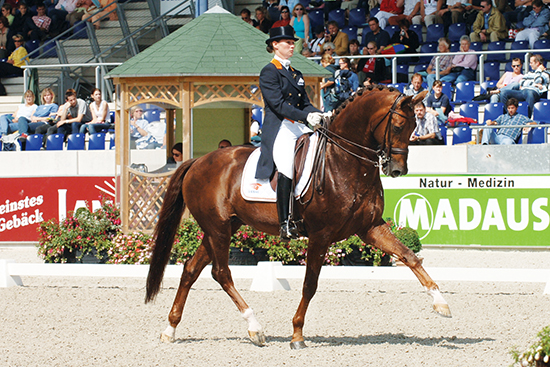
Jazz
A few words to the influence of Dutch dressage sires: The legendary Jazz is the frontrunner of the HEK-breed value estimation. The stallions Painted Black, his sire Gribaldi, Johnson by Jazz (currently number one in the WBFSH-world ranking of the best dressage producers) and Vivaldi by Krack C, a very popular stallion in Germany, are in the top ten of the highest assessed dressage horse producers with high breed values.
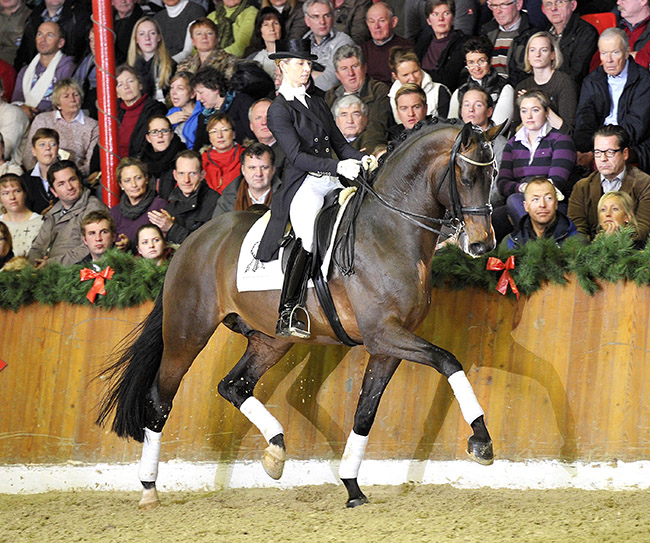
Bordeaux
The result of Bordeaux, by United, who returned from Schockemöhle’s station to the stallion station van Uytert in the Netherlands, is very impressive. His stallion registration was not continued for the year 2020 and hence, he is not listed in the chart. Bordeaux has been victorious in Grand Prix-classes up to the S4*-level, last with Isabel Freese. At the age of 14, he already has a HEK-breed value of 170. 28 descendants successfully compete in dressage classes at the S-level including five at the S***-level and three at the S****-level. On the damside, his heredity is well secured via the top producers Gribaldi and Donnerhall, but especially via his superior damline, which originated in Westphalia. His fourth dam Adone is a full sister to Reiner Klimke’s top horse Ahlerich and the dam of the Olympic champion Rembrandt, which Nicole Uphoff-Becker so successfully presented.
Regarding the FN-breed values of Dutch stallions, the following issues call for a more intense analysis:
– Numerous horses, which were bred in the Netherlands, are recorded in the breed value-estimation. It includes horses, which remained in Dutch ownership and only came to Germany for competitions. They often competed at the higher levels, and, hence, there are no results available from the lower levels.
– There is a discrepancy between the Hanoverian breed values dressage (which is based on evaluations in mares tests and at auction selections) and the sport breed values of the FN. The Hanoverian breed values for top dressage horse-producers often are unusually low. We shall shed light on this issue in one of the next issues of THE HANOVERIAN.
The Hannoveraner Verband with its mare books from Hannover and the Rhineland will also in the future be considered one of the most important producers of dressage horses of international calibre. The successes in young horse championships are an important basis, which this overview of the current breed value estimation shows. These championships are the first step to an international Grand Prix-career for many horses. And, in the end, that is what this is all about: Horses will be made available for top-level competitions. Many stallion managers realized this and allow their stallions to compete up to the most difficult level. As this overview shows, more and more stallions are available to breeders, which have confirmed their talent for the most difficult dressage exercises under competitive conditions. May these stallions be used!
Once again, Thank You to Ludwig!
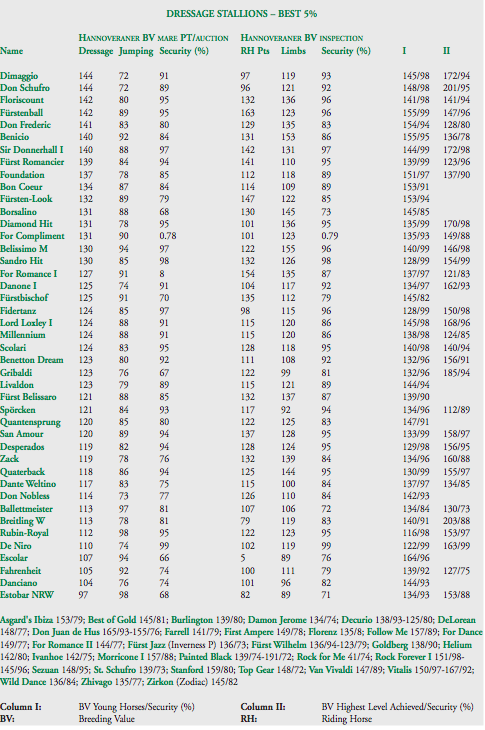
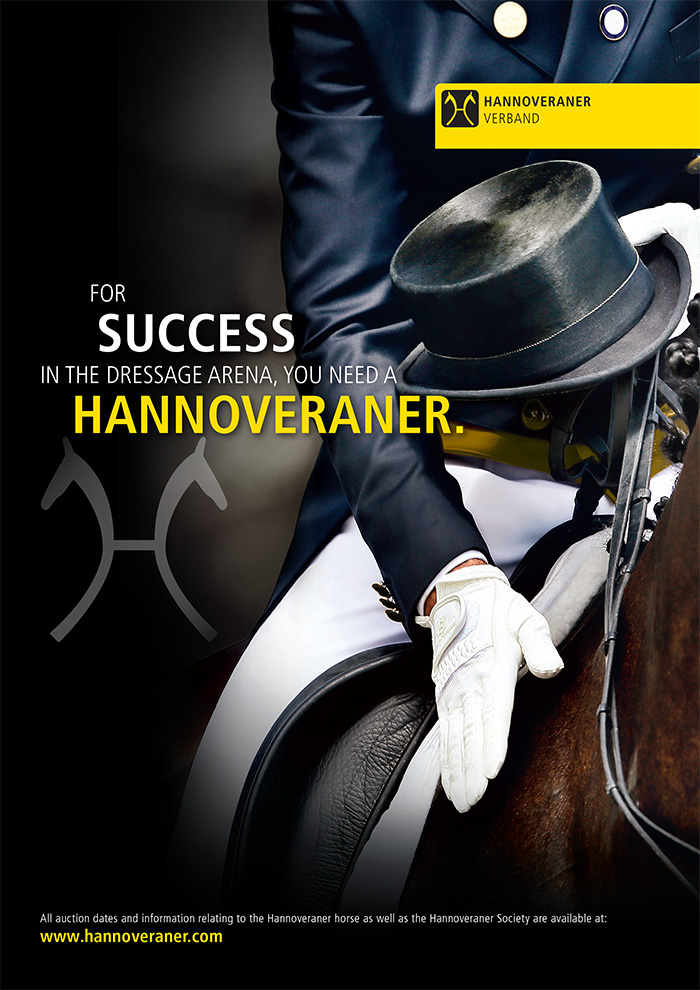



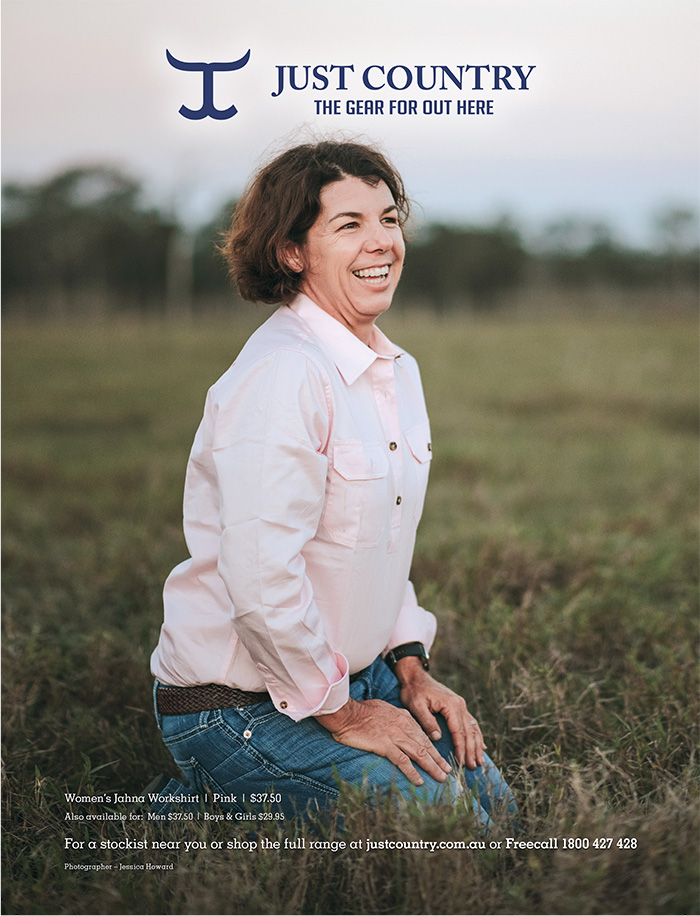
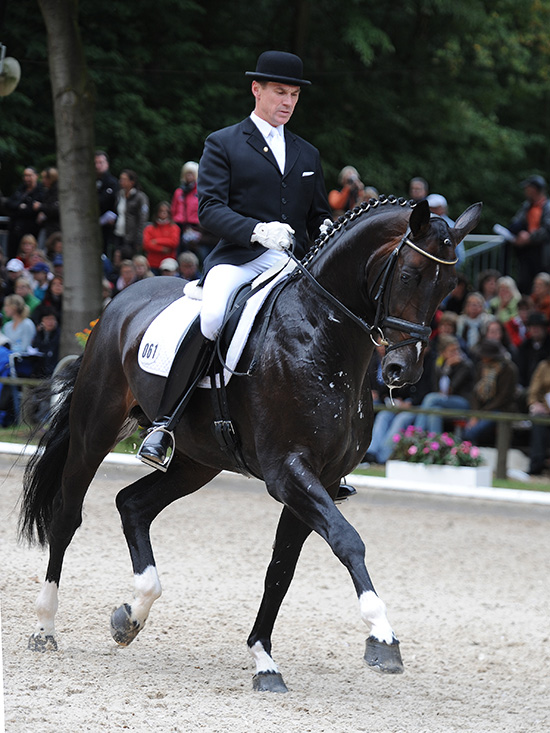
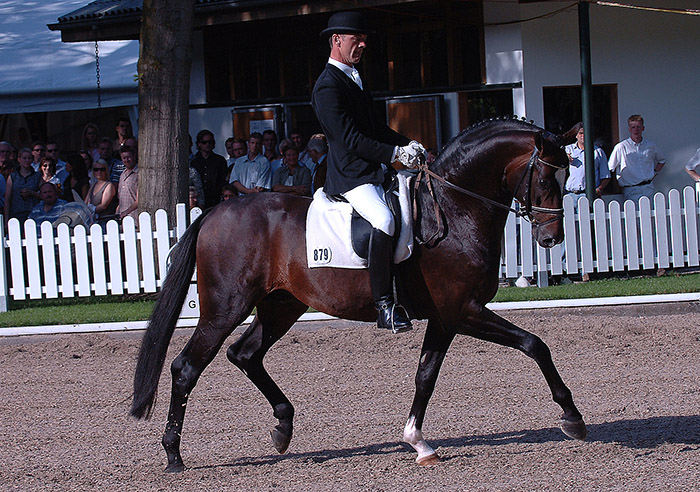
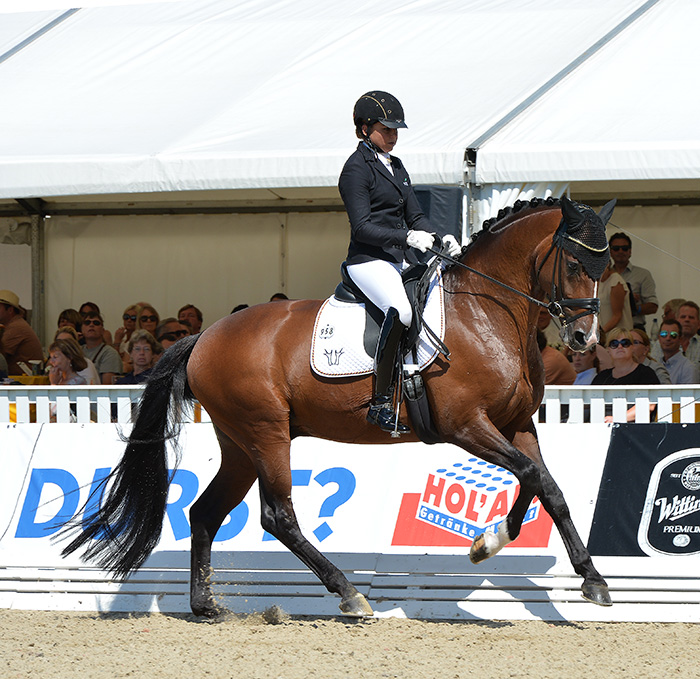
Thank you. Once again exhaustive research and readable assessments.